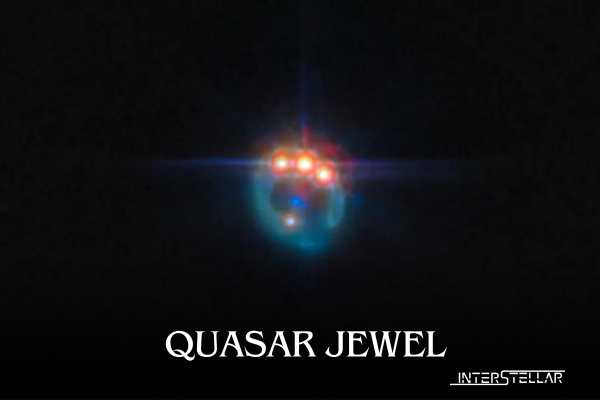Cosmic Jewel: James Webb Space Telescope Captures Quasar in Stunning Detail
A mesmerizing image of a sparkling jeweled ring, created by a cosmic phenomenon known as gravitational lensing, has been captured by the James Webb Space Telescope (JWST). This new image showcases a distant quasar, RX J1131-1231, situated about 6 billion light-years from Earth.
Unveiling the Cosmic Ring
The powerful gravitational field of a nearby elliptical galaxy warps the light from the quasar, an extremely luminous active galactic nucleus (AGN), resulting in a bright arc and duplicate views of the quasar. This warping effect creates a visual resembling gemstones on a ring. The elliptical galaxy, appearing as a small blue dot at the center of the ring, acts as a natural telescope, magnifying the light from the distant quasar which would otherwise be too far away to study in detail.
The Phenomenon of Gravitational Lensing
Gravitational lensing occurs when a massive object, such as a galaxy, bends the light from a more distant source. This effect allows astronomers to study regions near the black holes at the centers of distant quasars. Quasars are powered by large amounts of gas and dust falling into a galaxy’s supermassive black hole, making these regions shine brightly.
“Measurements of the X-ray emission from quasars can indicate how fast the central black hole is spinning, providing crucial clues about black hole growth over time,” stated European Space Agency (ESA) officials.
Insights from the Image
The JWST image, taken using its Mid-Infrared Instrument (MIRI), is part of a larger study of dark matter and its distribution in the universe. The elliptical galaxy’s gravitational lensing effect magnifies the light from RX J1131-1231, offering astronomers a closer look at the quasar.
“If a black hole grows primarily from collisions and mergers between galaxies, it accumulates material in a stable disc, leading to a rapidly spinning black hole,” ESA officials explained. “Conversely, if the black hole grows through numerous small accretion episodes, it accumulates material from random directions. Observations indicate that the black hole in this quasar is spinning at over half the speed of light, suggesting it has grown via mergers.”
Significance of the Discovery
The new observations, combined with previous data from other telescopes, make RX J1131-1231 one of the best-lensed quasars discovered to date. This finding not only enhances our understanding of black hole growth and quasar characteristics but also contributes to the study of dark matter and its role in the universe.


